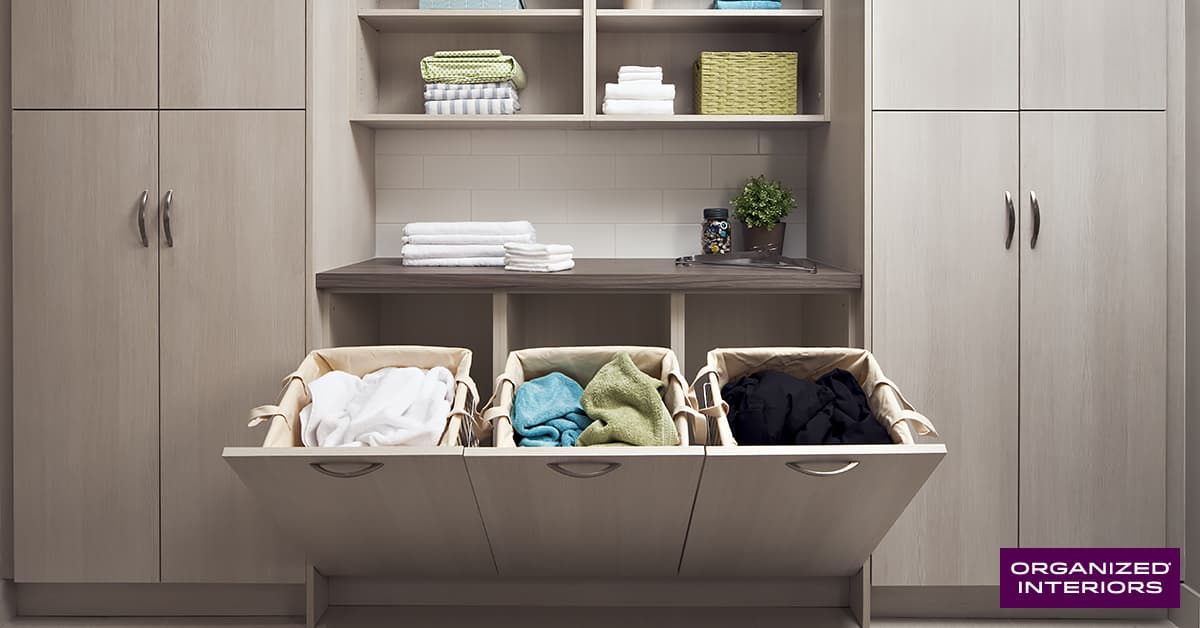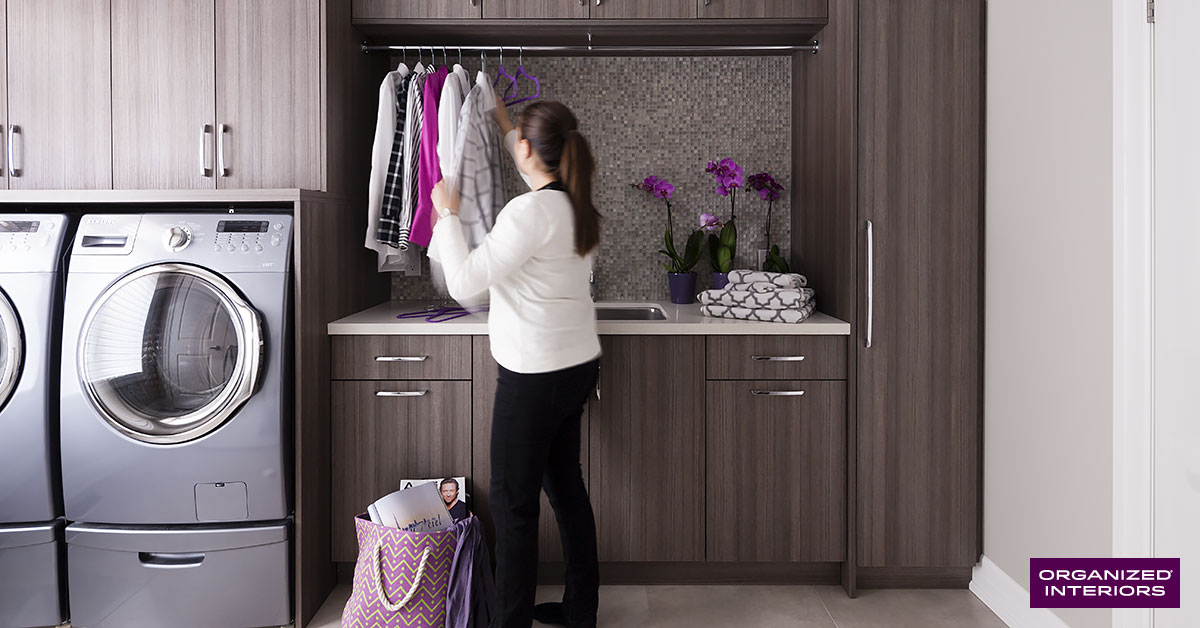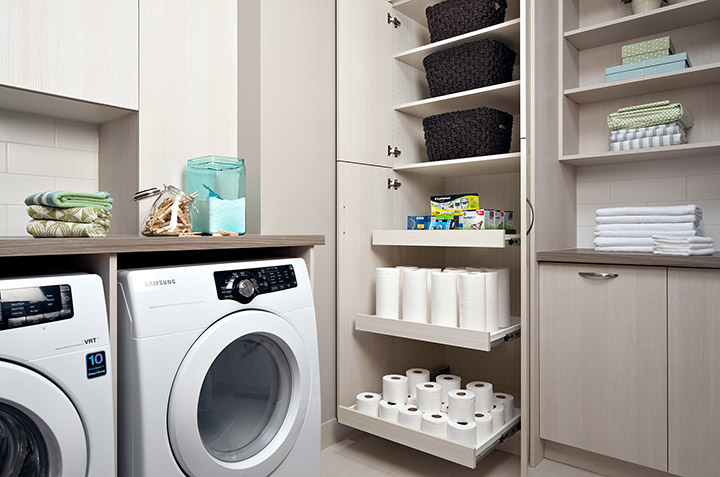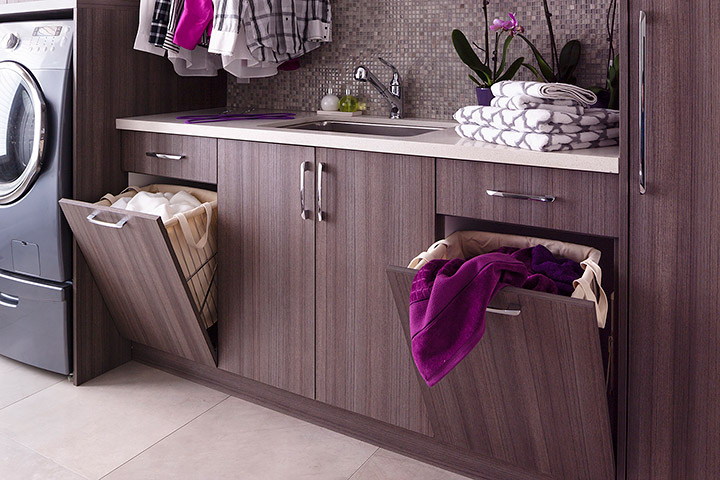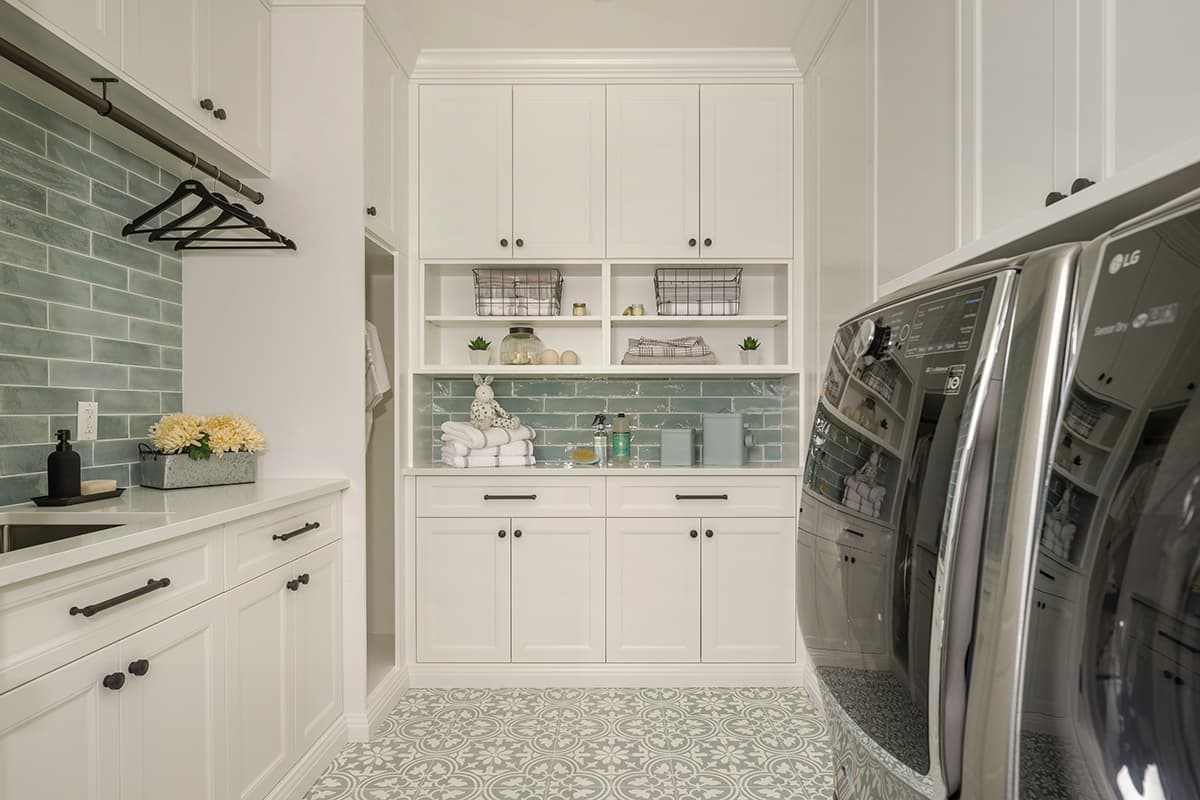
The once-neglected laundry room has undergone a major identity transformation. In recent years, the laundry room has consistently ranked as one of the most wanted features for home buyers.
The 2024 What Home Buyers Really Want Study found that the laundry room was the most desirable home feature for buyers. 86% of those surveyed chose it, which was tied with houses having a patio.
Home buyers and owners don’t just want a utilitarian room with minimal decorative appeal to wash and dry their clothes, either. Laundry room décor has taken on a new level of importance.
Laundry room makeovers have become very popular as homeowners seek to transform a traditionally drab space into an area they can style up with luxury touches and more modern amenities.
As an interior designer recently told Forbes, “No longer is the laundry room a forsaken, dreadful space. There is every reason to make a place used for chores enjoyable, cheerful and luxe.” An architect also tells Forbes that the laundry room “has emerged as a space ripe for innovation and creativity.”
Why nice laundry room décor matters
A laundry room deserves just as much attention as any other room in our homes. After all, they play a vital role in maintaining a clean and organized living space.
With some design creativity, a laundry room can become a space that is both highly functional and impressively stylish. This helps you get laundry tasks done more efficiently and the work can be done in a more comfortable, inviting space.
Laundry room décor upgrades make even more sense to invest in if the rest of your home has a high-end look. No longer does the laundry room have to be the “black sheep” room in your home that you’d prefer to keep hidden from the eyes of visitors.
From high-quality storage solutions to decorative accents to personalized touches, there are many ways to elevate the aesthetic of your laundry room.
Here are 15 laundry room décor ideas to help you revamp one of the home’s hardest working spaces.
1. Consider how the space will be used
One of the first considerations to make for a laundry room makeover is how the space will be used since this will inform your design choices.
Will it be a dedicated room purely for doing laundry or would you like to make it a dual-purpose space? Pairing laundry rooms with additional functionality has become increasingly popular as people look for ways to maximize their home’s space efficiency. Here are some examples of spaces that can be incorporated into a laundry room:
- mudroom
- home storage area
- crafting space
- home office
- pet grooming space
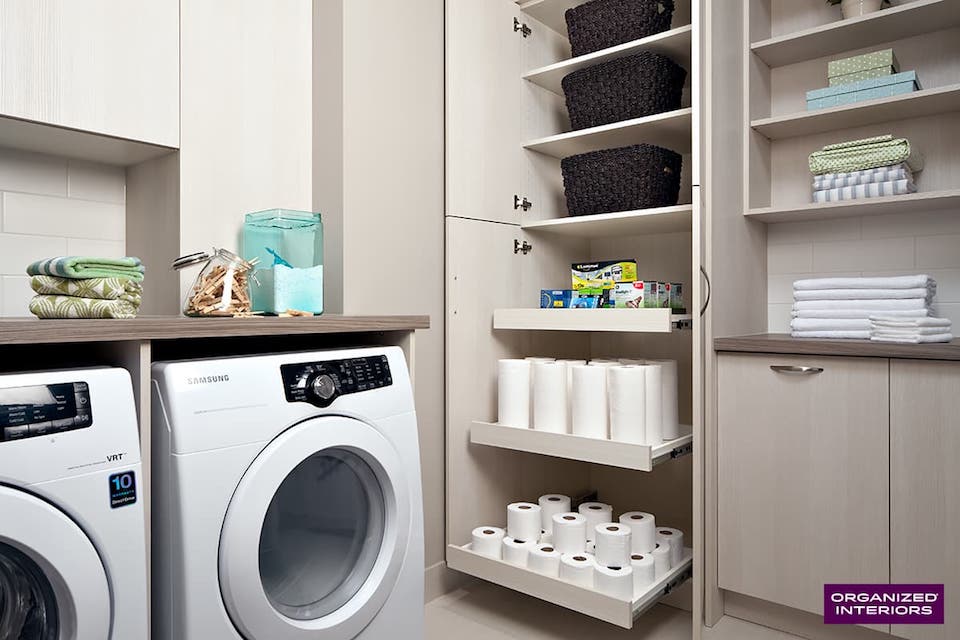
A well-designed laundry room can be a valuable home storage space.
2. Pick a practical location and functional layout
A practical location is essential for a laundry room. For convenience, designers typically recommend locating a laundry room near a home’s bedrooms or on the main floor close to the kitchen to allow for easier multitasking.
If a laundry room is beside or near the kitchen, more designers are even incorporating some of the kitchen’s design elements into the laundry room décor. For homes where the laundry room and mudroom are adjoined, this type of design symmetry is also practical.
Having a good laundry room setup is also important. A laundry room with a smart layout that is designed for optimal convenience and efficient workflow makes a significant difference.
3. Choose a laundry room décor style
There are a few ways to go when it comes to picking a laundry room décor style.
One popular design style is farmhouse chic, which gives laundry rooms a vintage look and a cozier feeling. To give the room an appearance that’s rustic and warm, farmhouse-style laundry room décor can incorporate elements like:
- a farmhouse sink with an antique-style faucet
- shaker-style cabinets
- cabinet hardware with a weathered, stylish look (like brass)
- faux wood flooring
- butcher block countertops
- shiplap walls
Another popular design aesthetic for laundry rooms is minimalist, which is all about simplicity. A minimalist-style laundry room keeps its design elements understated by using clean, straight lines, neutral colours, practical light fixtures, and simple cabinet and drawer hardware.
An industrial-inspired laundry room design can incorporate some minimalist design elements along with a few additions to give it a raw and edgy industrial look. Metal accents, stainless steel appliances, specific cabinetry hardware, and a muted colour palette help create a sleek industrial aesthetic.
Another approach is to have a laundry room designed with bold contrasting colours to create visual appeal. This could involve having the floor, walls, and ceiling a lighter colour and darker-coloured appliances, cabinetry, and work surfaces.
4. Pick a colour scheme and wall treatment
A laundry room’s colour scheme significantly impacts its overall ambiance. This article has some great ideas and inspiration for some laundry room colour ideas to consider. Be sure to choose a resilient, easy-to-clean semi-gloss paint that can handle the laundry room’s humidity.
Light and bright colours (like white, light gray, and pastels) can make a small space feel larger and help reflect light better. Bold colours (like red, navy blue, and emerald green) will add depth and character to a room.
In addition to the paint, here are a few other laundry room wall treatment options to consider:
- Wallpaper is one of the most impactful ways to add visual interest to the walls. Buy moisture-resistant PVC wallpaper and choose a design that suits your style.
- Shiplap walls are trendy and add texture and visual appeal. To avoid issues with heat and humidity, opt for vinyl, composite, or some type of moisture-resistant shiplap material as opposed to buying pine, cedar, or poplar shiplap.
- Incorporate ceramic tile backsplashes, which are decorative and very resilient. For an even more appealing room aesthetic, consider matching the tile floor and backsplash pattern.
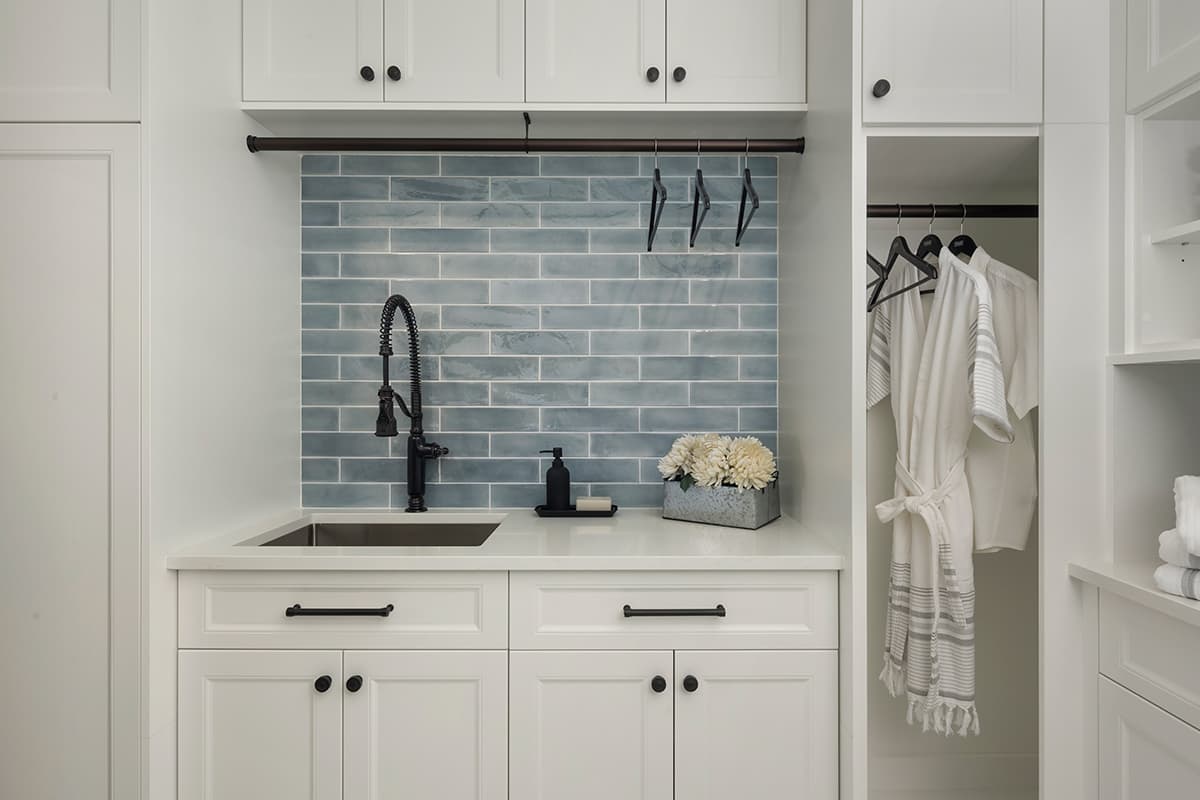
A tile backsplash or decorative feature like this faux brick wall treatment adds visual appeal.
5. Upgrade your laundry appliances
The washer and dryer are one of a laundry room’s focal points. If your appliances are past their prime, updating them to sleeker, more modern-looking models is worth considering.
Washers and dryers typically only come in a few neutral colours like black, white, and stainless steel gray, but you can still incorporate them into your decorative strategy. New appliances will play a role in refreshing the room’s appearance, too.
In addition to helping shape your laundry room décor, modern washers and dryers have convenient smart tech features that make it easier to get your laundry work done. They’re also significantly more energy-efficient.
To give your laundry room even more of a modern luxury look, consider adding a steam closet like the LG Styler. These new and innovative smart tech appliances feature a sleek design and enhance a laundry room’s functionality. They have a chemical-free dry cleaning system, can steam, deodorize, and sanitize garments, and gently dry clothing faster than air drying.
6. Choose stylish and durable flooring
Laundry room floors need to be a combination of durable, easy to maintain, and attractive. It’s also ideal if you can choose a flooring colour and style that complements the rest of your home’s décor to create a cohesive look.
Ceramic or porcelain tiles are excellent choices for laundry rooms because of their durability, water resistance, low-maintenance nature, and design possibilities. Patterned tiles can add a fun and unique element to the space.
Vinyl flooring has come a long way in recent years. It offers a wide range of styles and is very practical for a high-traffic area like the laundry room. It’s budget-friendly, too, although it’s worth spending a little more to get higher-quality luxury vinyl flooring.
If it’s a wood floor look you’re after, there are a few options. Laminate and hardwood are generally not recommended for laundry rooms because of their sensitivity to heat and moisture. Opinions on using engineered hardwood seem to be rather divided as well. Vinyl and luxury vinyl plank flooring that mimics the look of real wood are viable options.
Since all of the above flooring types are hard surfaces, a little comfort underfoot will be welcome. Add a machine-washable area rug, which adds warmth and texture, as well as another decorative element.
7. Add custom cabinetry
A major part of your laundry room décor comes from the storage cabinets. More homeowners and buyers want aesthetically pleasing storage systems, which is why you should invest in custom cabinetry.
Custom cabinetry allows for many more design options than store-bought products. Organized Interiors can tailor your custom cabinets to your exact taste. We offer hundreds of cabinetry finish options and a huge selection of decorative hardware to create a beautiful-looking laundry space.
When you invest in a custom design for your cabinetry, it’s easier to maximize the room’s storage potential as well. You can seamlessly accommodate appliances, countertops, and other room features and ensure no space is wasted. Using hidden storage for most of your laundry supplies helps the room maintain an attractive appearance and allows the space’s décor to stand out more.
As the main storage area of the laundry room, it’s essential to choose high-quality cabinets that can handle regular use. They also need to be resilient enough to handle the heat and moisture that comes with using a laundry room.
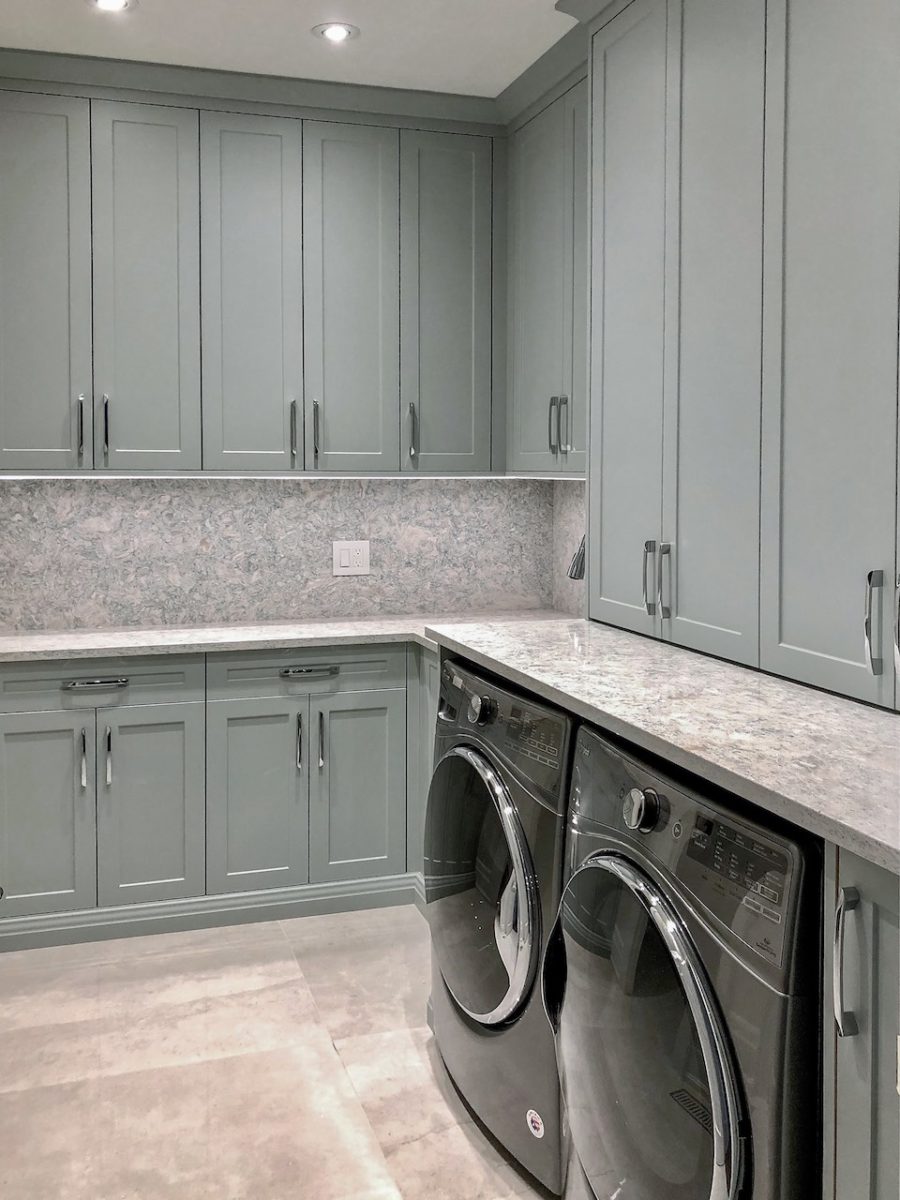
Store-bought cabinetry doesn’t compare aesthetically with stylish laundry room custom cabinetry.
8. Install custom countertops
A laundry room countertop also needs to look nice and be durable for a busy workspace. Materials like laminate, quartz, solid surface, and sealed butcher block are good choices.
Modern countertops offer a vast array of colours and finishes. From solid colours to faux stone designs, matching the countertop with the rest of the room’s design elements can elevate the look of the space.
A laundry room’s countertops get a lot of use. Be sure to create a large enough work surface to handle all of the laundry tasks you’ll be using the counters for like folding, sorting, treating stains, and mending items.
9. Add a high-end sink
A good laundry room sink is important to have for hand-washing, rinsing, and soaking clothes and the type you choose affects how your laundry room décor looks.
Avoid buying a plastic tub, which cheapens the look of a laundry room and tends to stain over time. Aim for a higher-end choice like porcelain, porcelain-coated steel, or stainless steel.
A farmhouse sink is a no-brainer for a farmhouse-style laundry room. A built-in sink makes efficient use of a small laundry room’s space, while a larger room may be more practical to incorporate a high-end freestanding sink, which adds decorative appeal.
For an extra sophisticated touch, outfit the sink with a luxury faucet. Consider getting a faucet model with a pull-down sprayer, which is convenient for some sink-related laundry tasks.
10. Add open shelving
Hidden storage has its benefits, but it’s smart to also incorporate open shelving in your laundry room design. Open shelving offers both practicality and style. It provides easy access to laundry essentials like detergent, fabric softener, and dryer sheets, making chores a little more efficient.
Open shelving also allows for decorative touches, such as adding plants, framed photos, or stylish containers to enhance the room’s aesthetic. Shelving is also useful for small areas or awkward corners that are less practical for cabinet usage.
Adding shelves to a laundry room may seem like a simple DIY job where you can just install some inexpensive white, brown, or black melamine shelving. By working with a design professional like Organized Interiors, we’ll ensure even this relatively small part of the room’s design looks great and perfectly complements the rest of your laundry room décor.
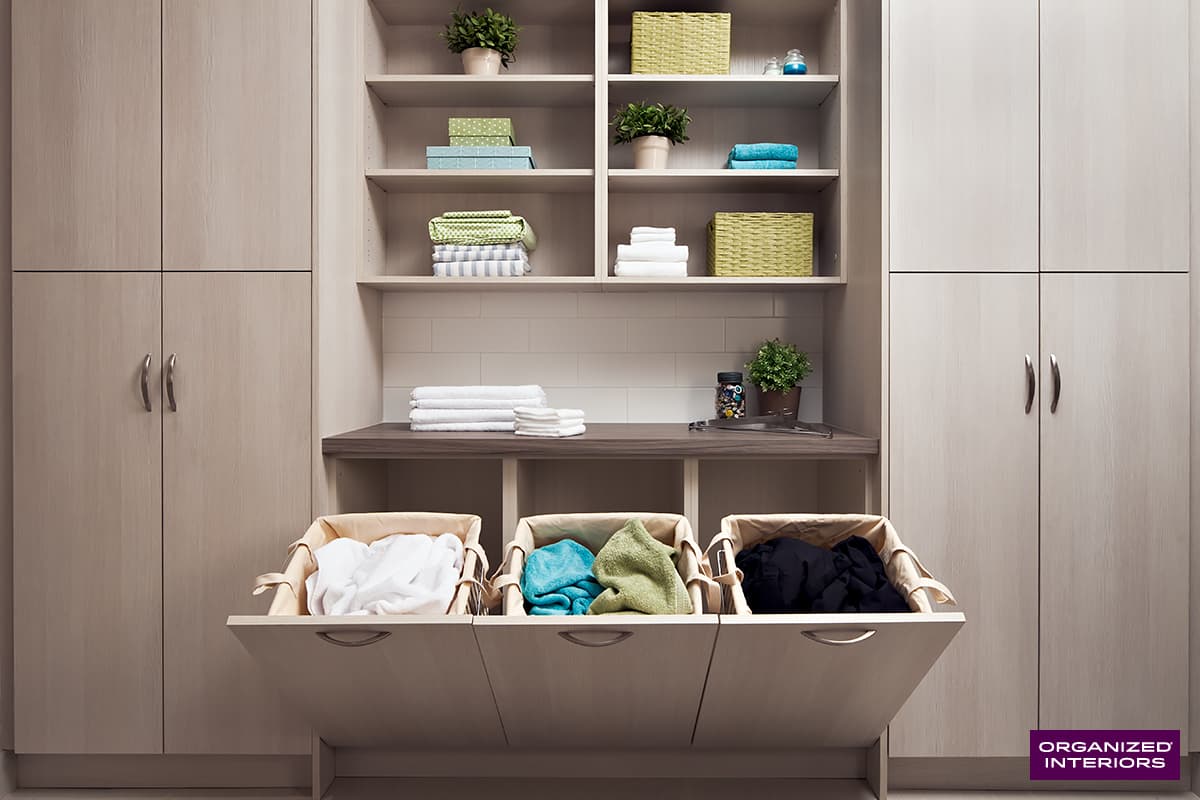
Open shelving allows you to add subtle decorative touches. Pullout hampers save space and help keep the room organized.
11. Add a stylish and functional island
Borrowing a design idea commonly used in luxury walk-in closets, adding an island gives a laundry room even more of an upscale look. Match the countertop and cabinetry styles with the room’s main counters and cabinetry setup for a consistent look.
A laundry room island is also very practical. They can be used for extra hidden storage and include open shelving or cubby storage. Any number of useful space-saving accessories like a pullout ironing board, hampers, and a drying rack can be incorporated into the design. Add drawers to store laundry and sewing supplies.
The top of the island also serves as a valuable extra work surface to fold and sort your laundry. A laundry room island also makes better use of the centre of a room with larger dimensions.
12. Choose stylish accessories
Some thoughtfulness and extra attention to detail with the smaller features that are part of a laundry room’s design help elevate its visual appeal.
If you invest in stylish accessories, your laundry room décor makes a better impression. Organized Interiors offers many types of stylish accessories for laundry rooms, including the following items:
- pullout laundry hampers
- hooks
- premium hanging rods
- pullout valet rods
- pullout hanging racks
These types of hanging accessories are perfect for air-drying delicate items or hanging freshly ironed clothes. Additionally, wall hooks can hold ironing boards, brooms, and mops, to keep the room’s floor space uncluttered.
Get some matching laundry baskets or hampers to not only streamline the laundry process but also give the room a cohesive look.
13. Use stylish storage containers
Instead of keeping your laundry supplies in their original plastic containers and boxes, transfer their contents to stylish glass jars, woven baskets, and ceramic canisters. Choose containers that complement your laundry room décor.
Large glass jars with airtight lids are perfect for storing powder detergent, clothespins, and other small items. They keep things organized while adding a touch of elegance.
For liquid detergents, fabric softeners, and stain removers, plenty of attractive glass and plastic products are available to keep them in, many of which have handy dispensers.
Woven baskets are both functional and decorative, adding texture and warmth to the space.
14. Personalize your space and add finishing touches
Once you have all of your laundry room décor essentials in place, it’s time to add some finishing touches with decorative accents that reflect your style and make the room feel inviting.
Here are a few things to consider adding to make the space uniquely yours:
- a dry erase board
- wall art like motivational quotes or a vintage laundry sign
- family photos
- real or artificial plants
- a stylish rug
- a comfy chair or stool
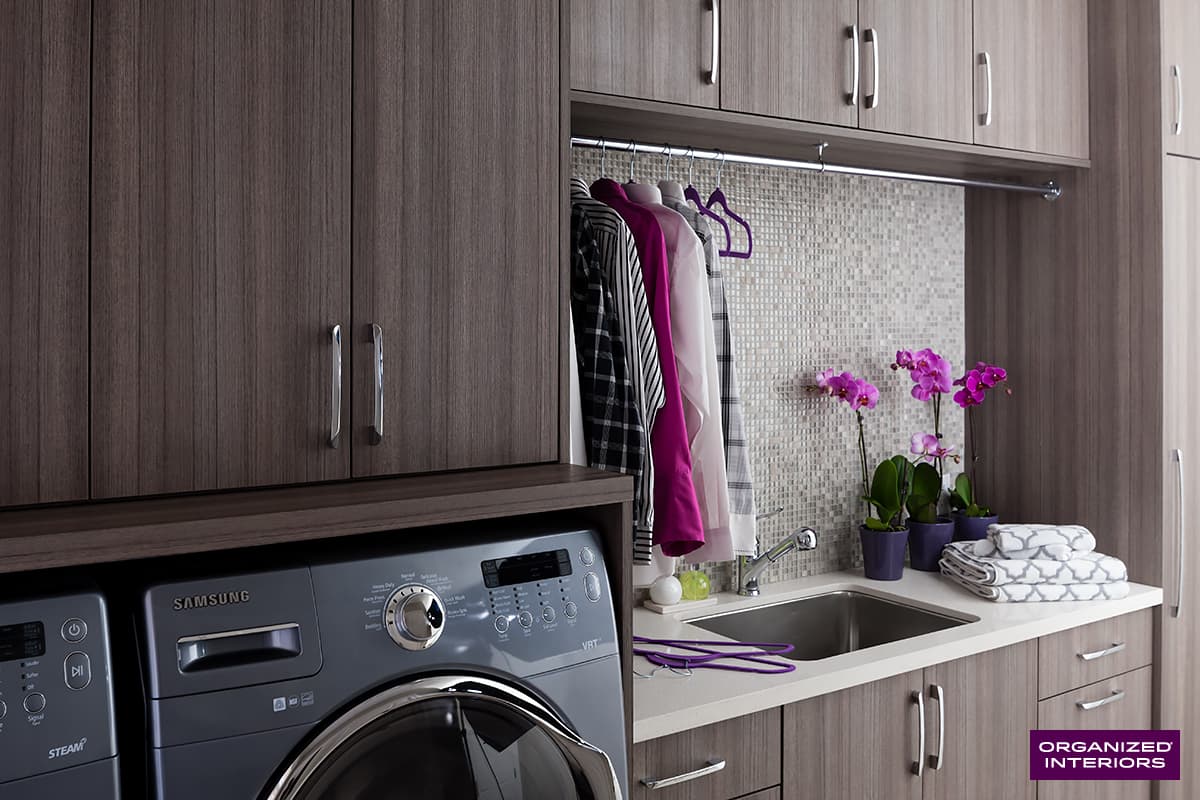
Personalize your laundry room with finishing touches like adding attractive flowers or plants.
15. Add lighting to enhance your laundry room décor
Last but not least to consider for your laundry room décor is the lighting. One reason laundry rooms often look and feel so dreary is because their main light source comes from an outdated single bulb or a fluorescent strip light.
Ensure you have adequate lighting for all your tasks, but don’t overlook the opportunity to add some stylish light fixtures. Proper lighting helps make any room feel more appealing and cozy and can showcase your laundry room décor upgrades to much greater effect.
Most types of overhead lighting fixtures are practical for a laundry room. Luckily, there are many models to choose from to complement the room’s style.
Considering that doing the laundry is one of a household’s most time-consuming chores, you’ll also want good task lighting to improve the room’s functionality. LED undercabinet strips are ideal for this. Use them to provide better illumination for your countertop areas.
Upgrade your laundry room décor
Transforming your laundry room into a more stylish and functional space makes a world of difference in how you perform your laundry tasks. With these laundry room décor ideas and upgrades, doing the laundry can become a more enjoyable and efficient task.
Are you thinking about investing in some much-needed laundry room upgrades? Schedule a free design consultation with Organized Interiors to discuss your laundry room remodel project goals and design options.
Please share this post if you found it useful.


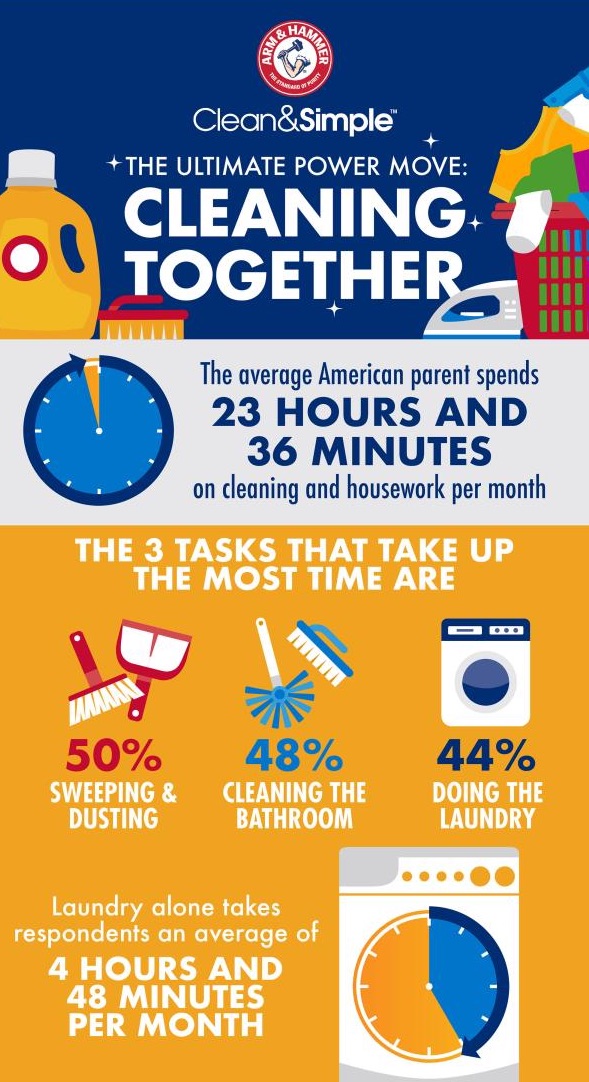
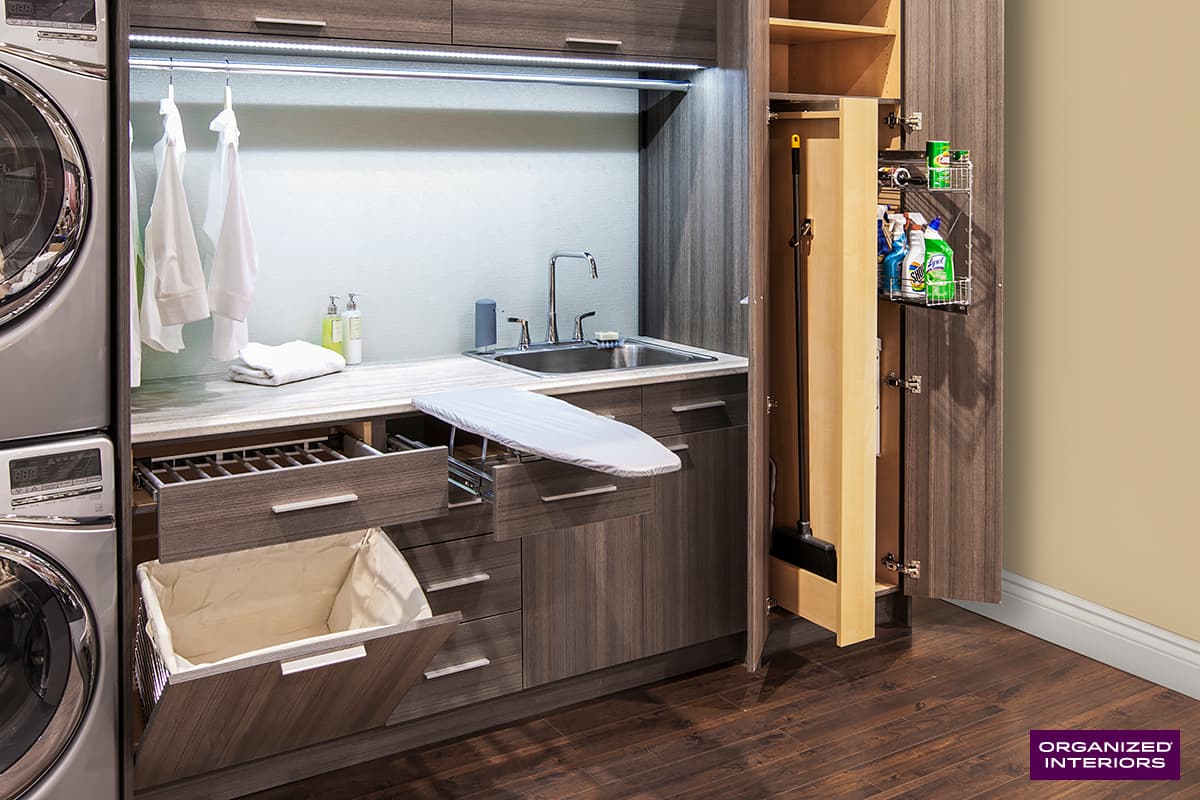
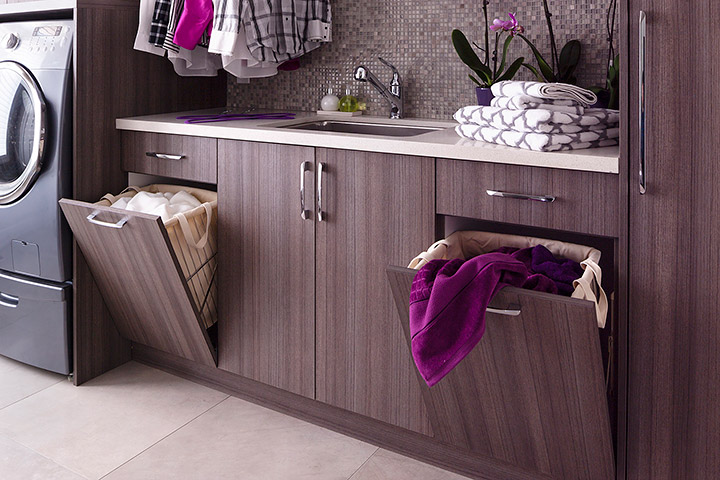
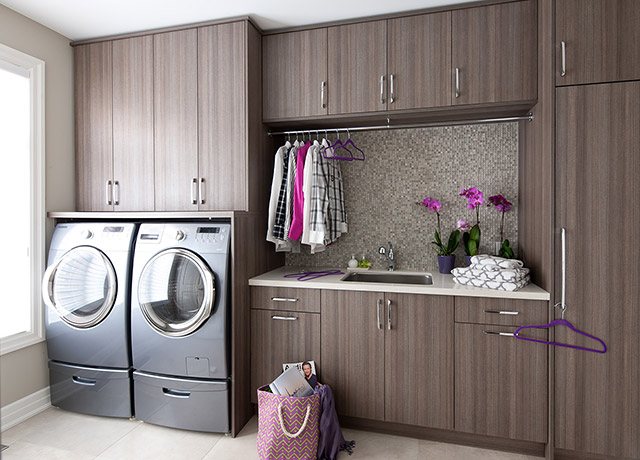
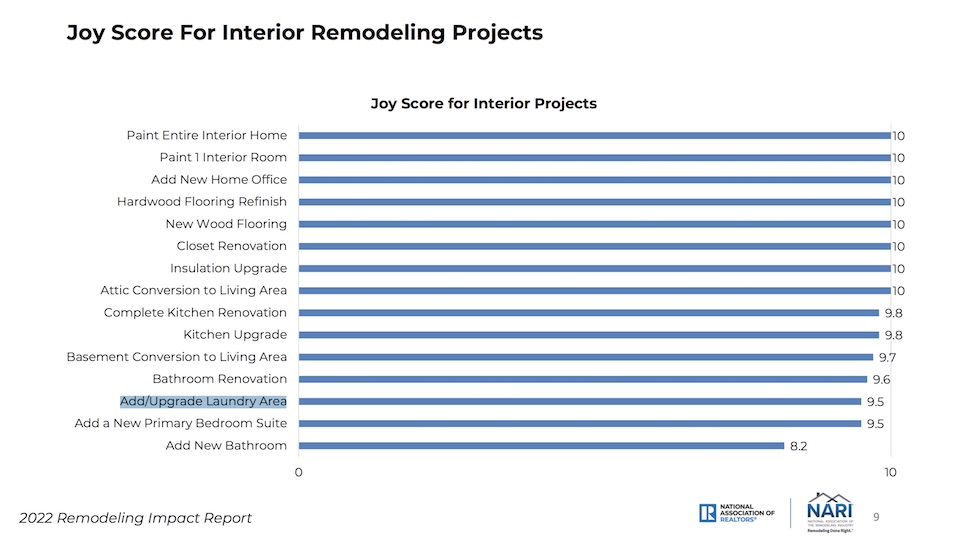
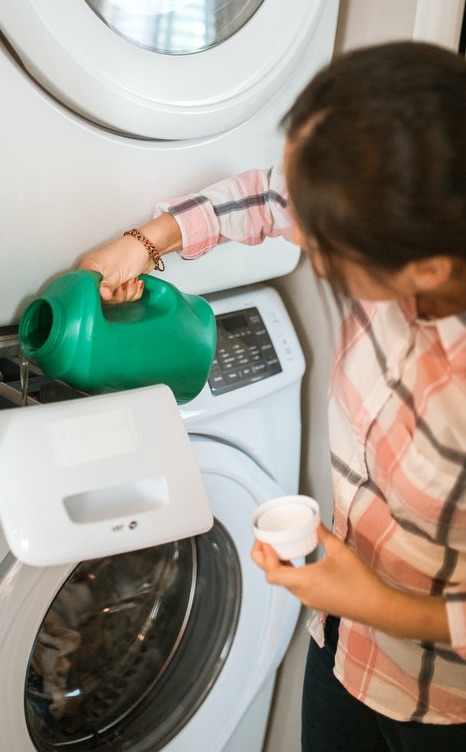
 Dryer sheets will get your clothes smelling more fragrant, but that highlights one of their negatives – they’re loaded with toxic chemicals that produce that pleasant smell and help them do their other jobs of softening clothes and reducing static.
Dryer sheets will get your clothes smelling more fragrant, but that highlights one of their negatives – they’re loaded with toxic chemicals that produce that pleasant smell and help them do their other jobs of softening clothes and reducing static.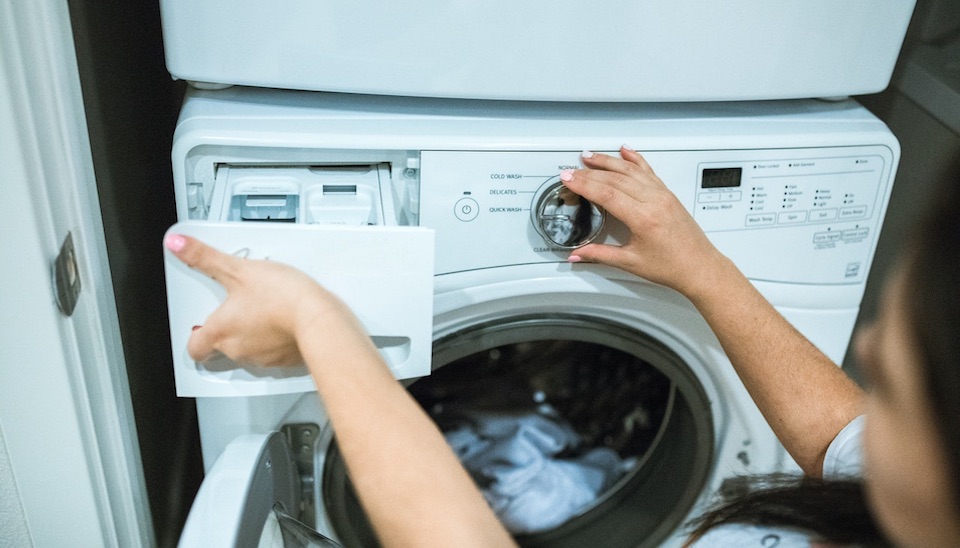
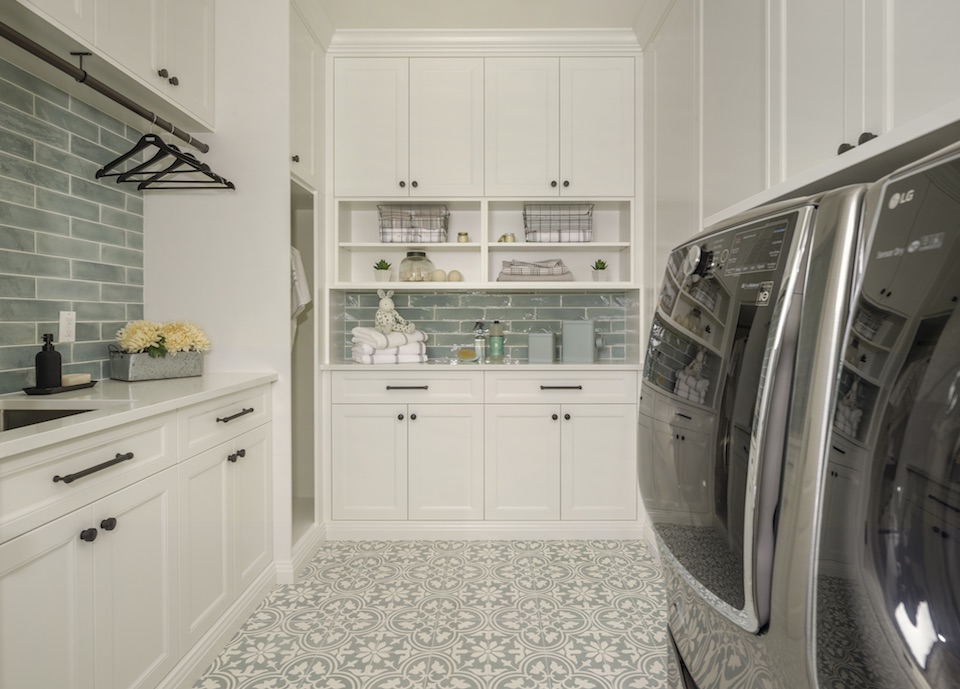
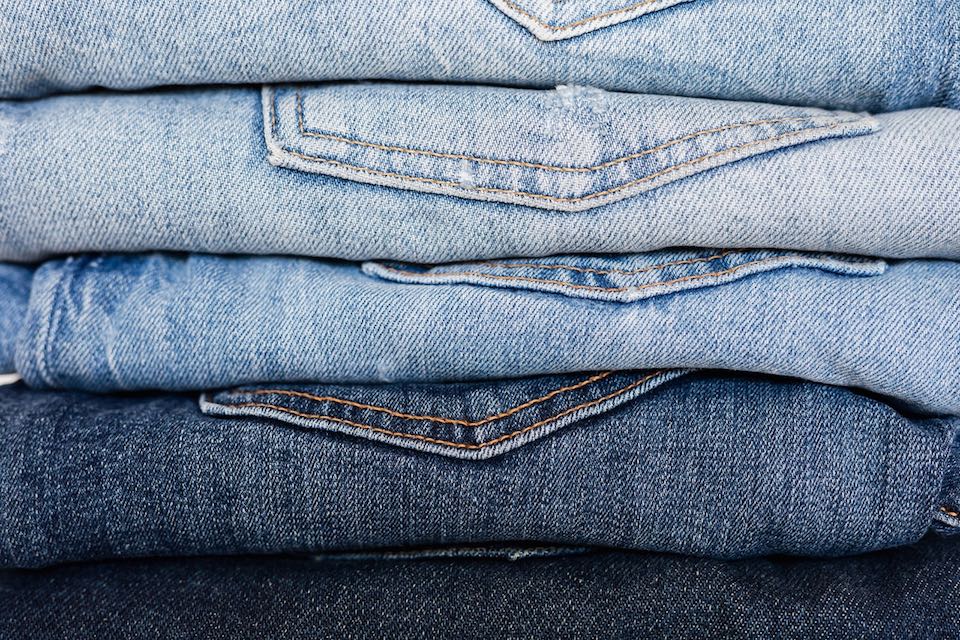
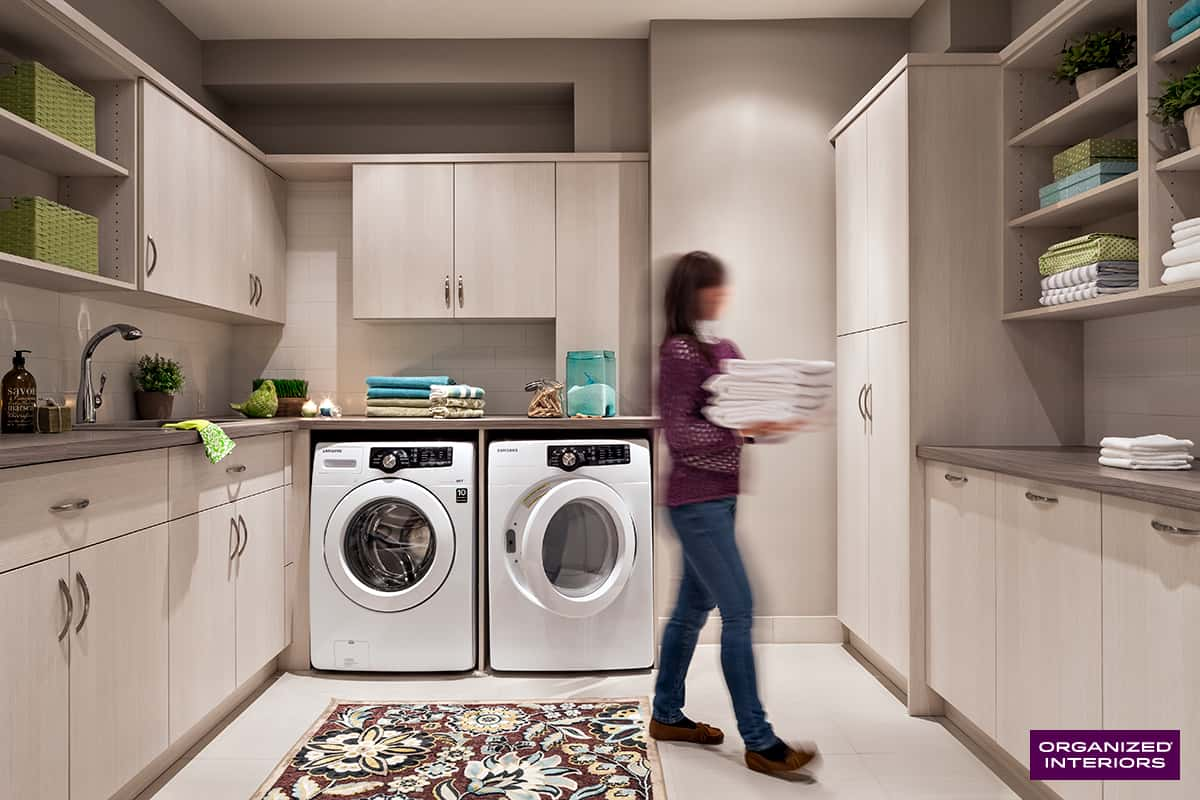
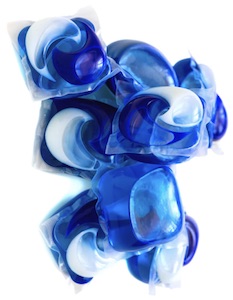 One of the other obvious safety issues with laundry rooms if you have youngsters or pets are the hazardous chemicals in your laundry products.
One of the other obvious safety issues with laundry rooms if you have youngsters or pets are the hazardous chemicals in your laundry products.